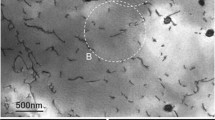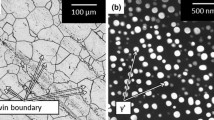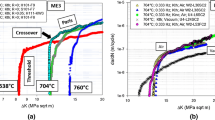Abstract
Two high strength P/M nickel-base superalloys, AF-115 and AF2-1DA, with different defect populations, were tested to determine the effect of preexisting defects on the fatigue crack initiation process. Strain controlled continuous cycle fatigue tests were performed at room and at elevated temperature; these were followed by fractographic examination to characterize both the location and character of the fatigue origins. In most cases, particularly at elevated temperature, the initiation process was associated with a large pre-existing defect, either a pore or a nonmetallic inclusion. There was also a change in the location of the crack that caused failure as the strain range varied: at high strain ranges initiation occurred at or near the specimen’s surface, while at the lower strain ranges the failure originated in the specimen’s interior. The initiation mode for both alloys at room temperature was different than at elevated temperature. At room temperature, Stage I crystallographic cracking at or near the surface dominated the process in all strain range regimes. This difference was attributed, in part, to the differences in deformation mode for nickel-base superalloys at room and elevated temperature.
Similar content being viewed by others
References
F. de Kazinczy:JIS1, 1970, vol. 207, p. 851.
M. Gell and G.R. Leverant:Trans. TMS-AIME, 1968, vol. 242, p. 1869.
J.C. Grosskreutz and G.G. Shaw:Fracture, Second International Conf. Fracture, Brighton, P. L. Pratt, ed., Chapman and Hall LTD, London, 1969, p. 620.
J. Lankford:International Metals Review, 1977, vol. 22, p. 221.
M. Gell and G.R. Leverant:Fatigue at Elevated Temperature, ASTM STP, Am. Soc. Testing and Mat’ls, 1973, vol. 520, p. 37.
J.C. Grosskreutz:Metal Fatigue Damage, S.S. Manson, ed., ASTM STP, Am. Soc. Testing and Mat’ls, 1971, vol. 495, p. 3.
J. M. Hyzak and I. M. Bernstein:Metall. Trans. A, 1982, vol. 13A, pp. 45–52
J.M. Hyzak: “The Effect of Defects on the Fatigue Crack Initiation Process in Two P/M Superalloys,” AFML-TR-80-4063, Air Force Materials Laboratory, Wright-Patterson AFB, Ohio, 1980.
C.H. Wells and C.P. Sullivan:Trans. ASM, 1968, vol. 61, p. 149.
B.A. Cowles, D.L. Sims, and J. R. Warren: “Evaluation of the Cycle Behavior of Aircraft Turbine Disk Alloys,” NASA Report CR159409, 1978.
V. Shahani and H. G. Popp: “Evaluation of the Cyclic Behavior of Aircraft Turbine Disk Alloys,” NASA Report CR-159433, 1978.
M. Gell and G. R. Leverant:Ordered Alloys, Third Bolton Landing Conf., AIME, Claitor’s Publishing, Baton Rouge, 1970, p. 505.
J. M. Oblak and B.H. Kear:Electron Microscopy and Structure of Materials, Univ. of California Press, Berkeley, 1972, p. 566.
L.F. Coffin, Jr.:Fatigue at Elevated Temperature, ASTM STP, Am. Soc.Testing and Mat’ls, 1973, vol. 520, p. 5.
C. Calabrese and C. Laird:Matl. Sci. and Engr., 1974, vol. 13, p. 141.
C. Calabrese and C. Laird:Matl. Sci. and Engr., 1974, vol. 13, p. 159.
C. Calabrese and C. Laird:Metall. Trans., 1974, vol. 5, p. 1785.
R. E. Stoltz and A. G. Pineau:Matl. Sci. and Engr., 1978, vol. 34, p. 275.
C. Laird:Fatigue Crack Propagation, ASTM STP, Am. Soc. Testing and Mat’ls, 1967, vol. 520, p. 131.
C. Laird and D.J. Duquette: Corrosion Fatigue, NACE-2, 1972, p. 88.
Author information
Authors and Affiliations
Additional information
Formerly with Metals and Ceramics Division, Air Force Materials Laboratory, Wright-Patterson AFB, OH.
Rights and permissions
About this article
Cite this article
Hyzak, J.M., Bernstein, I.M. The effect of defects on the fatigue crack initiation process in two p/m superalloys: part i. fatigue origins. Metall Trans A 13, 33–43 (1982). https://doi.org/10.1007/BF02642413
Received:
Issue Date:
DOI: https://doi.org/10.1007/BF02642413




